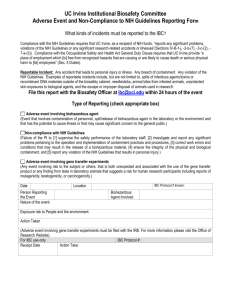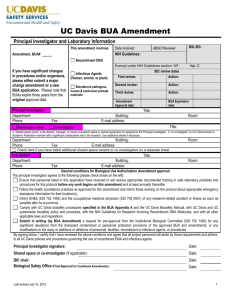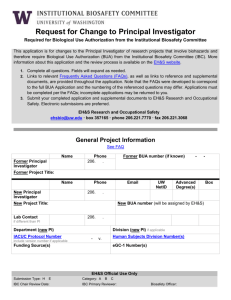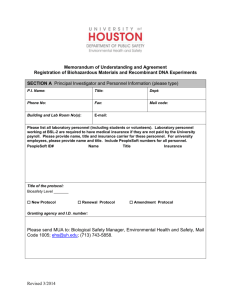USC Biohazardous Use Authorization (BUA)
advertisement
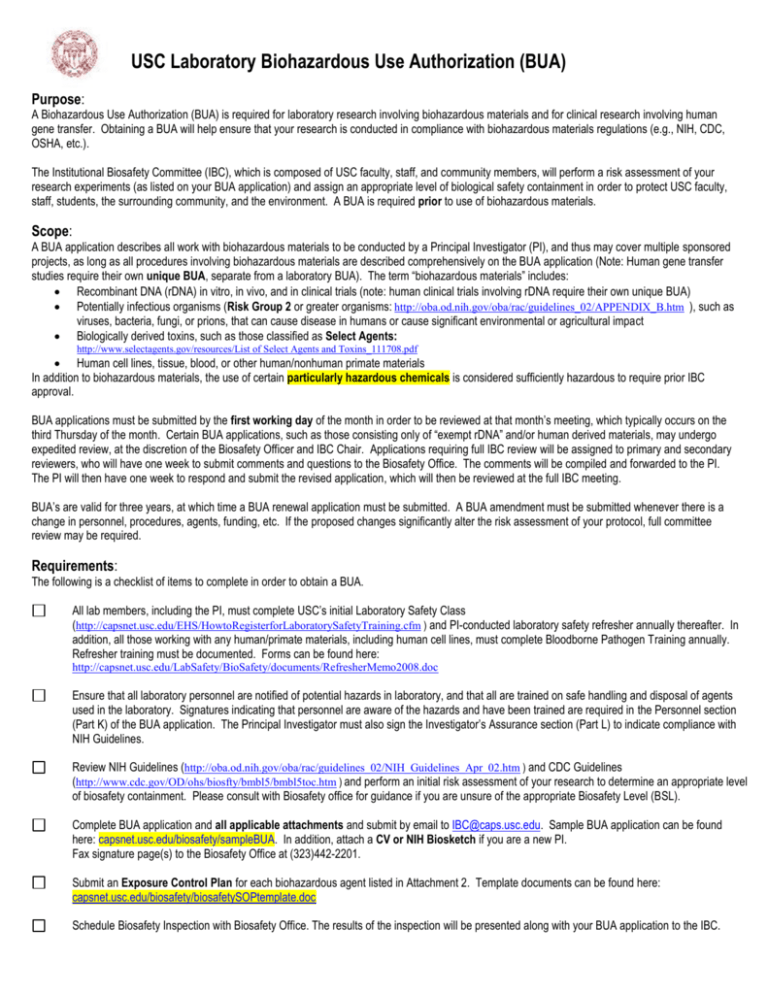
USC Laboratory Biohazardous Use Authorization (BUA) Purpose: A Biohazardous Use Authorization (BUA) is required for laboratory research involving biohazardous materials and for clinical research involving human gene transfer. Obtaining a BUA will help ensure that your research is conducted in compliance with biohazardous materials regulations (e.g., NIH, CDC, OSHA, etc.). The Institutional Biosafety Committee (IBC), which is composed of USC faculty, staff, and community members, will perform a risk assessment of your research experiments (as listed on your BUA application) and assign an appropriate level of biological safety containment in order to protect USC faculty, staff, students, the surrounding community, and the environment. A BUA is required prior to use of biohazardous materials. Scope: A BUA application describes all work with biohazardous materials to be conducted by a Principal Investigator (PI), and thus may cover multiple sponsored projects, as long as all procedures involving biohazardous materials are described comprehensively on the BUA application (Note: Human gene transfer studies require their own unique BUA, separate from a laboratory BUA). The term “biohazardous materials” includes: Recombinant DNA (rDNA) in vitro, in vivo, and in clinical trials (note: human clinical trials involving rDNA require their own unique BUA) Potentially infectious organisms (Risk Group 2 or greater organisms: http://oba.od.nih.gov/oba/rac/guidelines_02/APPENDIX_B.htm ), such as viruses, bacteria, fungi, or prions, that can cause disease in humans or cause significant environmental or agricultural impact Biologically derived toxins, such as those classified as Select Agents: http://www.selectagents.gov/resources/List of Select Agents and Toxins_111708.pdf Human cell lines, tissue, blood, or other human/nonhuman primate materials In addition to biohazardous materials, the use of certain particularly hazardous chemicals is considered sufficiently hazardous to require prior IBC approval. BUA applications must be submitted by the first working day of the month in order to be reviewed at that month’s meeting, which typically occurs on the third Thursday of the month. Certain BUA applications, such as those consisting only of “exempt rDNA” and/or human derived materials, may undergo expedited review, at the discretion of the Biosafety Officer and IBC Chair. Applications requiring full IBC review will be assigned to primary and secondary reviewers, who will have one week to submit comments and questions to the Biosafety Office. The comments will be compiled and forwarded to the PI. The PI will then have one week to respond and submit the revised application, which will then be reviewed at the full IBC meeting. BUA’s are valid for three years, at which time a BUA renewal application must be submitted. A BUA amendment must be submitted whenever there is a change in personnel, procedures, agents, funding, etc. If the proposed changes significantly alter the risk assessment of your protocol, full committee review may be required. Requirements: The following is a checklist of items to complete in order to obtain a BUA. All lab members, including the PI, must complete USC’s initial Laboratory Safety Class (http://capsnet.usc.edu/EHS/HowtoRegisterforLaboratorySafetyTraining.cfm ) and PI-conducted laboratory safety refresher annually thereafter. In addition, all those working with any human/primate materials, including human cell lines, must complete Bloodborne Pathogen Training annually. Refresher training must be documented. Forms can be found here: http://capsnet.usc.edu/LabSafety/BioSafety/documents/RefresherMemo2008.doc Ensure that all laboratory personnel are notified of potential hazards in laboratory, and that all are trained on safe handling and disposal of agents used in the laboratory. Signatures indicating that personnel are aware of the hazards and have been trained are required in the Personnel section (Part K) of the BUA application. The Principal Investigator must also sign the Investigator’s Assurance section (Part L) to indicate compliance with NIH Guidelines. Review NIH Guidelines (http://oba.od.nih.gov/oba/rac/guidelines_02/NIH_Guidelines_Apr_02.htm ) and CDC Guidelines (http://www.cdc.gov/OD/ohs/biosfty/bmbl5/bmbl5toc.htm ) and perform an initial risk assessment of your research to determine an appropriate level of biosafety containment. Please consult with Biosafety office for guidance if you are unsure of the appropriate Biosafety Level (BSL). Complete BUA application and all applicable attachments and submit by email to IBC@caps.usc.edu. Sample BUA application can be found here: capsnet.usc.edu/biosafety/sampleBUA. In addition, attach a CV or NIH Biosketch if you are a new PI. Fax signature page(s) to the Biosafety Office at (323)442-2201. Submit an Exposure Control Plan for each biohazardous agent listed in Attachment 2. Template documents can be found here: capsnet.usc.edu/biosafety/biosafetySOPtemplate.doc Schedule Biosafety Inspection with Biosafety Office. The results of the inspection will be presented along with your BUA application to the IBC. EH&S USE ONLY BUA# Approval date: Full IBC Expedited USC Biohazardous Use Authorization (BUA) Application Please complete all Parts A – L and any applicable Attachments. BSL: Part A. General Information P.I. name, degree: Lab contact name: Title: Title: Email: Email: Bldg, Room: Bldg, Room: Phone: Phone: Fax: Fax: New BUA Application BUA Renewal (BUA# ) BUA Modification (BUA# ) Part B. Project Information This application is designed to encompass the biohazardous research activities of your lab in a comprehensive manner, and is thus not limited to a specific grant or project. Please list below each grant/project to be covered by this application (note: all biohazardous procedures related to each listed grant/project must be comprehensively described on this application). In addition, please list the approval status or indicate N/A (Not Applicable) for grants/projects that involve vertebrate animal research (IACUC approval required), human subjects research (IRB approval required), or human stem cell research (SCRO approval required). Grant/Project Title(s): Granting Agency IACUC approval Y: # N/A Pending Y: # N/A Pending Y: # N/A Pending Y: # N/A Pending Y: # N/A Pending IRB approval Y: # N/A Pending Y: # N/A Pending Y: # N/A Pending Y: # N/A Pending Y: # N/A Pending SCRO approval Y: # N/A Pending Y: # N/A Pending Y: # N/A Pending Y: # N/A Pending Y: # N/A Pending click to add row Part C. Identification of Laboratory Biohazards Does your laboratory use the following biohazardous materials? Recombinant DNA (i.e. plasmids, viral vectors, creation of transgenic animals, human gene therapy, etc.) Potentially infectious organisms* or biologically derived toxins†, including Select Agents Human cell lines, blood, tissue, or other human/nonhuman primate materials Y N If “Yes,” please complete Attachment 1 in addition to Parts A-L Y N If “Yes,” please complete Attachment 2 in addition to Parts A-L Y N If “Yes,” please complete Attachment 3 in addition to Parts A-L *Risk Group 2 or greater viruses, bacteria, fungi, prions: http://oba.od.nih.gov/oba/rac/guidelines_02/APPENDIX_B.htm †List of Biologically derived toxins and Select Agents: http://www.hawaii.edu/ehso/bio/BSM_part23.htm Part D. Particularly Hazardous Chemicals The use of certain chemicals is considered sufficiently hazardous to require prior approval by the IBC. D1. Does your research involve any chemicals found on this list? Y If “Yes”, please complete Attachment 4 in addition to Parts A-L. N D2. Does your research involve administration of other hazardous chemicals, such as antineoplastics/cytotoxics, carcinogens, mutagens, or reproductive toxins to live animals? Y N If “Yes”, do you agree to adopt the IBC’s SOP for handling potentially contaminated animals/bedding? Y N N/A If “No”, please complete Attachment 4 in addition to Parts A-L. Part E. Radiation E1. Does your research involve radioactive materials, radiation producing devices, or X-ray producing devices? Y(list: , Radiation safety permit # ) N E2. Do any projects listed in Part B involve the exposure of live animals to radiation producing devices or radioactive materials? If “Yes”, has Radiation Safety Committee approval been obtained? Y N N/A Pending Y N Part F. Shipping and Transport of Biological Materials F1. Do you plan to ship any biological materials including: patient/clinical specimens, cell cultures, tissues, genetically modified organisms and/or infectious agents, toxins of biological origin or items on dry ice? Y N If “Yes,” current Saftpak training certificates for all certified shippers must be on file with the Biosafety Office prior to shipment F2. If infectious materials will be transported to/from your laboratory, do you agree to transport these materials within a primary container with sealed lid or top, which will then be enclosed in a secondary leak-proof container and labeled with a biohazard symbol? Y N, explain: N/A Part G. Research Locations Please list all laboratory and/or animal research locations associated with the projects listed on this application, the biological agents that are used in these locations, and the Biosafety Level (BSL) of these rooms. The BSL, in general, should reflect the risk group of your agents (note: human/nonhuman primate materials should be handled at BSL2 containment). Please contact the Biosafety Office if you are unsure of the BSL for a room, or to schedule a laboratory biosafety inspection. Bldg/Rm e.g., CHP 148 List Biological Agents (i.e. human cell lines, toxins, microbial agents) e.g., E coli. 0157:H7 BSL of room BSL1 BSL2 BSL2+ BSL1 BSL2 BSL2+ BSL1 BSL2 BSL2+ BSL1 BSL2 BSL2+ BSL1 BSL2 BSL2+ BSL1 BSL2 BSL2+ BSL1 BSL2 BSL2+ click to add row Part H. Non-Technical Summary In lay language, provide a summary of your laboratory’s research objectives, including the purpose, goals, and anticipated outcomes of your research. Part I. Experimental Procedures and Research Methodology Please describe in detail all experimental procedures/methods used by your laboratory involving biohazards/chemical hazards identified in Parts C and D. Identify each agent (e.g., specific cell lines, recombinant plasmids, viral vectors, etc.), its purpose, and how it is used. (See our sample form for examples of common laboratory procedures: capsnet.usc.edu/biosafety/sampleform). Part J. Risk Assessment Based on your risk assessment, what overall level of biosafety containment do you propose to use for this research? (Note: the overall BSL should reflect the highest level of biosafety containment to be utilized) BSL1 BSL2 BSL2+ N/A Part K. Authorized Personnel Please list all laboratory personnel and the agents they will handle. Approval will only be given for personnel identified below, and is specific for the agents listed. Signatures are required to indicate that personnel have been informed of potential hazards, safe work practices, and that they understand and will follow approved laboratory standard operating procedures. All laboratory personnel must complete USC’s Laboratory Safety Class; PI-conducted safety refresher training is required annually thereafter. All laboratory personnel who handle human materials or other potentially infectious material must complete annual bloodborne pathogen training. Individuals may access their lab training records at: http://srm.usc.edu/ Date of last Title (PI, Post Date of last lab bloodborne Agents Handled (i.e. Name, degree Doc, Grad Signature safety training/ pathogen cell lines, viral vectors) Student, Tech.) refresher training (or N/A) click to add row Part L. Investigator’s Assurance I agree to perform all activities according to the NIH Guidelines for Research Involving Recombinant DNA Molecules and use biosafety practices described in the CDC/NIH Publication Biosafety in Microbiological and Biomedical Laboratories (BMBL), and to report any research-related accidents or incidents to the IBC as required by the NIH Guidelines. Additional conditions required by the IBC will also be followed. __________________________________________ Principal Investigator _____________ Date Please fax signed page to Biosafety Office at (323)442-2201 Attachment 1: Recombinant DNA 1a. All recombinant DNA research at USC must abide by NIH Guidelines, regardless of funding source. Recombinant DNA experiments are classified into different categories by the NIH based on potential hazards (See NIH Guidelines Section III). The category that your experiment falls under will determine the type(s) of approval(s) required to initiate your research. Important Note: While certain recombinant DNA experiments are considered by the NIH Guidelines to be exempt (Section III-F), research of this nature must still be registered with the IBC in order to confirm exemption status. Please check all applicable boxes. NIH Guidelines Section III: http://oba.od.nih.gov/oba/rac/guidelines_02/NIH_Guidelines_Apr_02.htm - _Toc7261559 NIH Guidelines Risk Groups: http://oba.od.nih.gov/oba/rac/guidelines_02/APPENDIX_B.htm SECTION III of NIH Guidelines. III-A. Experiments that Require IBC Approval, RAC Review, and NIH Director Approval Before Initiation. 1a. Deliberate transfer of drug resistance trait to microorganisms that are unknown to acquire the trait naturally, if such acquisition could compromise use of the drug to control disease agents in humans, veterinary medicine or agriculture. III-B. Experiments that Require NIH/OBA and IBC Approval Before Initiation. 1. Experiments Involving the Cloning of Toxin Molecules with LD50 of Less than 100 Nanograms Per Kilogram Body Weight. III-C. Experiments that Require IBC and IRB Approvals and RAC Review Registration Before Research Participant Enrollment 1. Experiments Involving the Deliberate Transfer of Recombinant DNA or DNA or RNA Derived from Recombinant DNA into One or More Human Subjects (human gene transfer). III-D. Experiments that Require Institutional Biosafety Committee Approval Before Initiation (Most rDNA experiments involving eukaryotic viruses or viral sequences) 1. Human or animal pathogen (defined as Risk Group 2, 3, 4, or Restricted Agents) used as either the host organism or as a vector (i.e., adenoviral and lentiviral vectors) 2. Cloning of DNA from all Risk Group 2, 3, 4, or restricted human or animal pathogens (including HIV and related viruses and viruses capable of infecting human cells.) 3. Experiments using more than 2/3 of the genome (i.e., standard adenoviral vectors) of infectious animal or plant viruses or defective viruses grown in the presence of helper virus or complementing helper virus components. 4. Recombinant DNA experiments involving whole animals (including Drosophila), such as transgenic or knockout rodent experiments requiring BSL2 containment (note: most transgenic/knockout rodent experiments fall under III-E-3); or transplantation of recombinant microorganisms (e.g., adenoviral vectors) into animals. 5. Recombinant DNA experiments involving whole plants. 6. Large scale rDNA projects (≥10 liter cultures at any moment in time). III-E. Experiments that Require Institutional Biosafety Committee Notice Simultaneous with Initiation (USC IBC must be notified to confirm status prior to initiation). 1. Experiments involving the formation of recombinant DNA containing no more than 2/3 of the genome of any eukaryotic virus, demonstrated to be free of helper virus components. 3. Experiments involving the generation of rodents in which the animal’s genome has been altered by stable introduction of rDNA or DNA derived therefrom into the germ-line (transgenic or knockout rodents) for which BSL-1 containment is appropriate (NOTE: the purchase or transfer of transgenic rodents for BSL-1 experiments falls into the “exempt” category; however, breeding of these animals with different strains of mice is considered a non-exempt rDNA experiment). III-F. Recombinant DNA molecules considered exempt by NIH (USC IBC must be notified to confirm exemption status) 1. Those not in organisms or viruses 2. DNA segments from a single non-chromosomal or viral DNA source 3. DNA from prokaryotic host when propagated only in that host or transferred to another host by well established physiological means. 4. DNA from an eukaryotic host when propagated only in that host (or closely related host). See NIH Appendices A-I through A-VI for a list of natural exchangers. 5. DNA segments from different species that exchange DNA by known physiological processes. 6. Those that do not present a significant risk to health or the environment (see Appendix C) Appendix C-I: Recombinant DNA in tissue culture – rDNA containing less than ½ of a eukaryotic viral genome propagated in cell culture (with the exception of expression of DNA from Risk Group 3, 4 or restricted agents) Appendices C-II, C-III, C-IV: Recombinant DNA work involving E. coli K12 derivatives, S. cerevisiae, B. subtilis and B. licheniformis host-vector systems (with the exception of DNA from Risk Group 3, 4 or restricted agents) Appendix C-VI: The purchase or transfer of transgenic rodents 1b. Viral Vector Information Please complete this section for the use of viral gene transfer vectors, otherwise skip to 1c. Retrovirus Vectors Lentivirus Vectors Source (name company or lab): Source (name company or lab): Will vectors be produced in lab? Y N Will vectors be produced in lab? Y N Estimated max. titer/ml: max. vol: Estimated max. titer/ml: max. vol: Virus type: MLV FeLV RSV Other: Virus type: HIV FIV Other: Host Range/Tropism (check all that apply): Host Range/Tropism: Ecotropic (i.e, murine host range only) VSV-G Pseudotype (broad host range) Amphotropic (broad mammalian host range) Other: VSV-G Pseudotype (broad host range) Production Method: Avian only Identify helper plasmids used in co-transfection to produce viral Other: particles: Production Method: Transient Transfection Identify helper plasmids used in co-transfection to produce viral Packaging/Producer cell lines: particles: Vector system: Transient Transfection 2nd generation(3 plasmids) Packaging/Producer cell lines: 3rd generation (4 plasmids) Replicative Potential: Other, describe: Replication defective, explain how: Replicative Potential: Replication competent, justify: Replication defective, explain how: Testing for the presence of Replication Competent Lentivirus (RCL) is encouraged for all uses of lentivirus vectors, but only required for Adenovirus Vectors certain experiments, such as human clinical trials or expression of Source (name company or lab): known oncogenes. Will vectors be produced in lab? Y N Do you plan to test for the presence of RCL? Y N Estimated max. titer/ml: max. vol: If “Y”, describe method: Virus type: Ad5 Other: Alteration to natural host range/tropism? Y N If “Y”, describe: Other Viral Vectors Virus genotype: ΔE1 ΔE1/E3 Other: Virus type: AAV Baculovirus SFV Other: Production Method: Source (name company or lab): Homologous recombination in helper cells (e.g., 293A cells) Will vectors be produced in lab? Y N Homologous recombination in bacteria/amplify in helper cells Estimated max. titer/ml: max. vol: Other, describe: Describe host range: Replicative Potential: Describe production method: Replication defective, describe method to test for presence of Replicative Potential: replication competent Adenovirus (RCA): Replication defective, describe: Replication competent, justify: Replication competent, justify: 1c. Host/Vector/Gene Information Please complete the table below describing all rDNA research performed by your lab (note: include any viral vectors described in 1b). Host used for propagation or as target Vector Species from Use of Construct (i.e. Nature of Insert or Protein recipient of (name bacterial Genetic Insert which genetic cloning for sequencing, expressed (i.e., oncogene, rDNA plasmid, cosmid, (avoid acronyms) insert is PCR, expression in cell transcription factor, etc.) (i.e. E. coli K12, virus, BAC, etc.) derived culture, etc.) mammalian cell line, animal) Green Aequorea e.g., Mouse Adenoviral vector Fluorescent Victoria Reporter Expression in mouse Protein (jellyfish) Major Immune system peptide Over expression of e.g., E. coli K-12 pET21 Histocompatibility Mouse binding protein protein in E. coli Complex Class II Risk Group/ BSL of Host or Vector (indicate highest) 2 1 click to add row 1d. Are any rDNA materials used in human subjects? (Note: Human Gene Therapy BUA applications should be submitted separately from laboratory BUA applications) Y N If “Yes,” please attach the following documents, otherwise skip to 1e: NIH Recombinant DNA Advisory Committee (RAC) review letter Clinical protocol Responses to Appendix M of the NIH Guidelines 1e. Will rDNA be used for production of transgenic or knockout animals? (Note: For purchase or transfer of transgenic rodents, or breeding of transgenic rodents to maintain a line, please answer “N” as these are considered “exempt,” from NIH Guidelines. Creation of transgenics by (1) direct microinjection of a chosen gene construct from another member of the same species or a different species into the pronucleus of a fertilized ovum, (2) insertion of the desired DNA sequence by homologous recombination into an in vitro culture of embryonic stem cells, (3) use of a plasmid or virus to transfer the genetic material into germ cells, or (4) crossing different transgenic lines to create a novel transgenic, requires an answer of “Yes” as these are considered “non-exempt”): Y N If “Yes,” please complete the following, otherwise skip to 1f: i. Indicate the animal species, genetic insert/knockout, and function of genetic insert/knockout: ii. Will these modifications to the genome cause the animal to shed infectious agents, toxins, or create other hazards for the animal handlers and research staff? Y N iii. Will any transgenics be introduced into the wild?: Y N 1f. Are any rDNA materials or recombinant organisms administered to live animals? Y N If “Yes,” indicate the species of animal, the maximum concentration of materials to be administered, and the route of administration: 1g. Do you agree to adhere to the USC IBC emergency plans for handling accidental spills and personnel contamination? Y N, explain: Attachment 2: Potentially Infectious Organisms or Biologically Derived Toxins, including Select Agents 2a. If your work involves biologically derived toxins, please complete all questions for section 2a, otherwise skip to 2b. i. Name of toxin(s): ii. Source(name company or lab): iii. In what form is the toxin received (i.e. lyophilized powder, liquid): iv. Will you reconstitute the toxin? Y N If “Yes,” please describe: v. Highest concentration at any one time: vi. LD50 in ng/kg: 2b. Please complete the table below for all potentially infectious organisms (i.e. bacteria, viruses, fungi, prions) used in your laboratory Microbe (i.e. Staphylococcus aureus) Source (i.e. ATCC) Risk Group / Biosafety Level Approximate max. volume handled/cultured at any one time Approximate max concentration handled/cultured at any one time Manipulations (i.e.injection, sonification, blending, pipetting, etc.) e.g., Group A Streptococcus ATCC 2 10mL 1x10^7 cfu/ml Culturing,diluting, pipetting click to add row 2c. Are any of the materials listed in “2a” or “2b” administered to live animals? Y N If “Yes,” indicate the species of animal, the maximum concentration to be administered, and the route of administration: 2d. Are any of the materials listed in “2a” or “2b” classified as Select Agents? Y N If “Yes,” please complete the following questions: i. If toxin, what is the maximum amount that your laboratory will have at any one time (enter “N/A” if not applicable): ii. If toxin, do you qualify for exclusion from Select Agent registration (i.e., toxin amount below regulated level)?: Y, describe: N N/A iii. If microbe, indicate the strain used: Does this strain qualify for exclusion from Select Agent registration ?: Y N N/A If toxins/microbes are not excluded from Select Agent Regulations, then you must register your work with the CDC and/or USDA. Please contact the Biosafety office for details on this process. 2e. Please complete and attach a laboratory Agent Exposure Control Plan for each agent identified in “2a” and “2b”. Sample Agent Exposure Control Plans can be found at the USC Biosafety Website: capsnet.usc.edu/biosafety/sampleECP Agent Exposure Control Plans are to be read and followed by all laboratory members, and must be stored within the laboratory in a readily accessible location. Attachment 3: Human cell lines, blood, tissue, or other human/nonhuman primate materials 3a. Please complete the table below for the handling or culture of human/nonhuman primate materials, including blood, fluid, unfixed tissue specimens, and cell lines. Per OSHA Bloodborne Pathogen Standard, the use of any of these materials requires Annual Bloodborne Pathogen Training. All personnel must complete this training if not completed within the last year. Please note that the CDC/NIH guidelines recommend that human/nonhuman primate materials be handled at a minimum of BSL2 containment. Species e.g., Human e.g., Human Established and characterized cell lines (e.g., from ATCC) Embryonic or Adult Stem Cell Line** Cells/Tissues/Organs/ Specimens Manipulations (i.e.injection, sonification, blending, pipetting, etc.) Cell lines(293T, HeLa) Pipetting 10mL Blood, serum from HIV patients Centrifuging, pipetting 5mL Primary (fresh) material* High likelihood of being infectious Max. vol. handled at any one time click to add row * The use of primary material may require IRB approval or exemption ** The use of human embryonic or adult stem cell lines requires Stem Cell Research Oversight (SCRO) Committee approval 3b. Are any of the above listed materials administered to live animals? Y N If “Yes,” please indicate the animal species, the maximum amount of material to be administered, and the route of administration: 3c. Do you agree to adopt and follow the procedures outlined in USC’s exposure control plan for bloodborne pathogens and to update your plan annually and as needed? Y N, explain: Attachment 4: Standard Operating Procedure for Hazardous Chemicals NOTE: You will need a Material Safety Data Sheet to complete this form. MSDS’s can be obtained at: http://capsnet.usc.edu/ehs/MSDSOnline.cfm Please retain an MSDS in your laboratory for all registered materials. All of the following must be answered for this form to be complete; If not applicable please type “N/A”. 1. Chemical or toxin name: and Chemical Abstract Services (CAS) registry number: 2. If Toxin, source: 3. LD50 (oral) or LC50 for rats: 4. List any constraints on this material as they apply to personnel, room numbers, etc.: 5. a) What room will this chemical be stored in? (Please mark an “s” next to shared room #) b) What room(s) will this chemical be used in? (Please mark an “s” next to shared room #) 6. Describe how you will use the above listed chemical or toxin. Include descriptions of the procedures, concentration at which it will be used, the frequency of use, etc: 7. Containment during use: Open Bench No containment is necessary because: Fume hood Draft shielded scale 8a. Procedures will (check all that apply): Generate dust or aerosol(s) Involve sharps associated hazard(s): (please explain) 8b. Please explain the precautions taken to protect personnel from the risks indicated above: Other (specify): Involve live animals Other 9a. Max quantity used at any time (mg, ml, etc.): 9b. Max quantity expected in laboratory at any time: 10. Administrative controls: Please describe processes or procedures established by the Principal Investigator for the purpose of reducing personnel exposure. Examples include: specific training, special procedures, access restriction, and prohibited activities, etc.: 11. Engineering Controls: Please describe the safety equipment that must be accessible and used while working with the above listed hazardous chemical. Examples include: chemical fume hoods, biological safety cabinets, etc.: 12. Personal Protective Equipment: Please describe the personal protective equipment that must be accessible and used while working with the above named hazardous chemical. Examples include: gloves, eye protection, lab coats, etc. Please be specific. 13. Waste Disposal: What kind of hazardous waste, if any, will be generated from working with this chemical, and how will you dispose of it? What decontamination procedures will take place in order to assure safe and proper waste disposal? 14. Emergency Procedures: Please describe the methods you will use to clean up an accidental spill of this chemical (either large or small scale) or to execute an emergency shut down in the event of a power outage or other emergency while performing experiments with this chemical. Be sure to include: The concentration and contact time of any cleaning or deactivating agents. Spill kits and any other necessary supplies to be used. Signs and symptoms of exposures (e.g., appearance, odor, irritation, etc.) Emergency procedures



